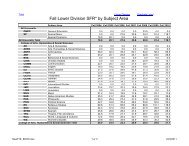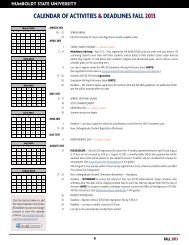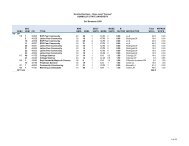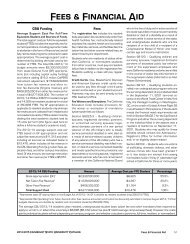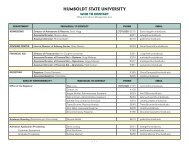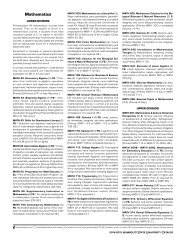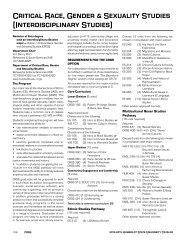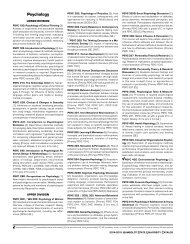2007-08 Academic Year - Humboldt State University
2007-08 Academic Year - Humboldt State University
2007-08 Academic Year - Humboldt State University
You also want an ePaper? Increase the reach of your titles
YUMPU automatically turns print PDFs into web optimized ePapers that Google loves.
Components of the Degree<br />
120 units<br />
40 upper division (B.A. majors)<br />
The major requires from 24 to 80 units.<br />
In general, 15 units per semester each fall and spring semester<br />
leads to graduation in 4 years. Some majors may require more.<br />
Check you major’s 4-year plans available at<br />
www.humboldt.edu/~humboldt/programs/type.<br />
The general education (GE) component requires 48 units. These<br />
units may simultaneously satisfy major, minor, or diversity/common<br />
ground requirements.<br />
Diversity & common ground (DCG) requires two courses. These<br />
may simultaneously satisfy major, minor, or GE requirements.<br />
The elective component can be from 0 to 40 units,<br />
depending on the chosen major and/or minor.<br />
An optional minor requires from 12 to 24 units.<br />
The Institutions component requires two courses or exams;<br />
one Institutions course may count in G.E.<br />
Major &<br />
Electives<br />
Minor<br />
(optional)<br />
General<br />
Education<br />
Institutions<br />
DCG<br />
• Liberal Studies/Elementary Education,<br />
and Liberal Studies/Child Development<br />
(Elementary Education) majors have<br />
GE requirements incorporated into the<br />
major requirements.<br />
• Environmental Resources Engineering<br />
majors should consult their advisors<br />
regarding special provisions for fulfilling<br />
GE.<br />
• Students must complete GE Basic Subjects<br />
and Mathematical Concepts/Quantitative<br />
Reasoning courses with grades of<br />
C- or higher.<br />
• Students must complete GE Basic Subjects<br />
(Area A) and Mathematical Concepts/Quantitative<br />
Reasoning courses (a<br />
portion of Area B) by the time they earn<br />
60 units. Transfer students who come<br />
to HSU with more than 30 units, must<br />
complete these courses by the time they<br />
earn 30 units at <strong>Humboldt</strong>.<br />
• Information and advice regarding GE requirements<br />
are available at the Advising<br />
Center, SBS 295.<br />
Lower Division Component<br />
Students must complete a minimum of 36<br />
lower division units in approved GE courses.<br />
These break down to a minimum of nine units<br />
in each of four areas, designated A, B, C, and<br />
D. Each area has specific requirements and<br />
goals, described on the following pages.<br />
NEW THIS YEAR —<strong>Humboldt</strong> Connections<br />
– Radical! In this exciting new GE option,<br />
students will be able to enroll in linked interdisciplinary<br />
GE courses on topics relevant<br />
to the <strong>Humboldt</strong> region. Students may take<br />
Area A courses with a thematically linked<br />
Area D or Area C GE course. This two year<br />
pilot program begins in Fall <strong>2007</strong>. Courses<br />
in the program will be labeled 109 R – R<br />
for Radical!<br />
The two options offered are:<br />
1) ENGL 100R: First <strong>Year</strong> Reading and<br />
Composition taken concurrently with<br />
ENGL/GEOG 109R: Off the Beaten Path:<br />
Exploring <strong>Humboldt</strong> through Literature and<br />
Landscapes. These courses count for Area<br />
A and either Area C or D.<br />
2) FOR 100R: Critical Thinking taken concurrently<br />
with NRPI/PSCI 109R: Shake,<br />
Rattle and Roll: Organizing Communities for<br />
Disaster. These courses count for Area A<br />
and Area D.<br />
Upper Division Component<br />
Upper division GE courses build upon knowledge<br />
and abilities developed in lower division<br />
GE courses. Students must complete nine<br />
upper division units: three units each from<br />
areas B, C, and D.<br />
In addition, all students need three units<br />
in an area E course (human integration).<br />
<strong>Humboldt</strong> <strong>State</strong> offers area E courses at<br />
an upper division level, but transfer students<br />
can meet the requirement with transferable<br />
lower division units appropriately certified by<br />
a CSU or California Community College.<br />
Transfer Students<br />
Students who transfer to <strong>Humboldt</strong> from a<br />
California Community College, and who have<br />
followed the approved CSU or IGETC general<br />
education pattern, may satisfy up to 39<br />
semester units of GE with transfer course<br />
work. Transfer students from accredited<br />
private or non-California colleges will have<br />
their transfer courses applied to GE through<br />
individual review of transcripts.<br />
Send transcripts of all previous work to<br />
the Office of Admissions. A Degree Audit<br />
Report for Students (DARS) will be made<br />
available at the time of orientation or initial<br />
enrollment that indicates how courses taken<br />
elsewhere apply to <strong>Humboldt</strong>’s all-university<br />
requirements (general education, American<br />
institutions, diversity and common ground,<br />
unit minimums and limits, etc.) and in many<br />
cases, the major program. The DARS report<br />
also reflects HSU courses completed<br />
and in-progress, and is available to enrolled<br />
students whose first term of enrollment was<br />
fall 2003 and later.<br />
A minimum of nine units of GE course work<br />
must be completed in residence (i.e., at<br />
<strong>Humboldt</strong>) to satisfy the residency requirement.<br />
You should expect to have to<br />
study at least two hours per<br />
week per unit of coursework in<br />
order to succeed.<br />
A student taking a full load<br />
of 15 units should study 30<br />
hours per week.<br />
<strong>2007</strong>-20<strong>08</strong> <strong>Humboldt</strong> <strong>State</strong> <strong>University</strong> Catalog<br />
Planning Your Bachelor’s Degree<br />
45



